National Institutes of Health
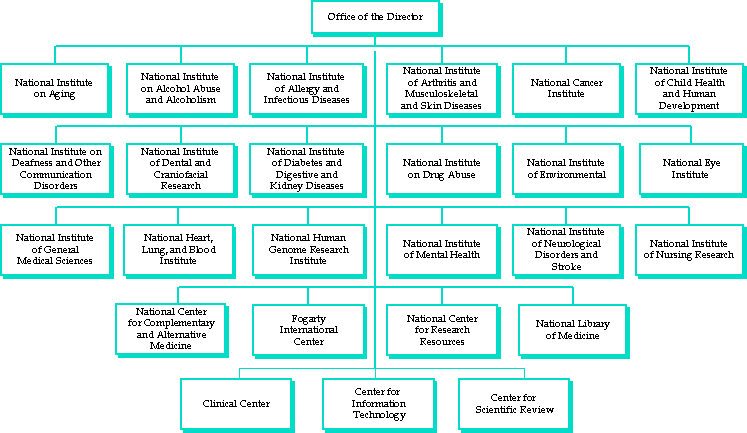
| 国立保健医療科学院 公衆衛生政策部長 曽根 智史 |

| 1. | 27のInstitute/Center | ||||
| 2. | 2つのfunding機能
| ||||
| 3. | 年間予算(2002年)29億ドル(約3兆5000億円) 5年前から倍増。今後も増額傾向。 |
| 4. | 2種類のfunding
| ||||
| 5. | グラントには様々な種類があり、ポスドク支援(個人・大学)、small business支援、各institute独自のプログラムなどが含まれる。基本的に臨床研究支援が主体。 | ||||
| 6. | グラントには、research moneyの他にindirect costが含まれる。 |
| 1. | 専門家による申請書の審査を指す。 |
| 2. | NIHでは、3/4がCSR(Center for Scientific Review)で、残りが各Instituteで行われる。 |
| 3. | NIHでは、分野ごとにreviewerが一堂に会して行われるのが特徴である。 |
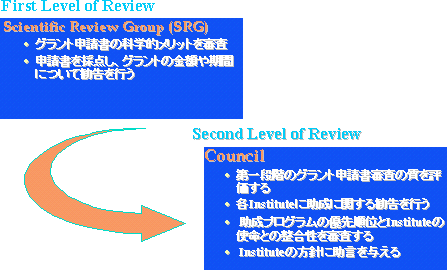
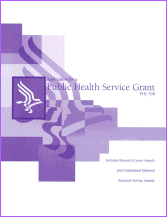 |
Mail Completed Forms To: CENTER FOR SCIENTIFIC REVIEW NATIONAL INSTITUTES OF HEALTH ROCKLEDGE II ROOM 1040 MSC-7710 BETHESDA MD 20892-7710 Also available at http://grants.nih.gov/grants/oer.htm |
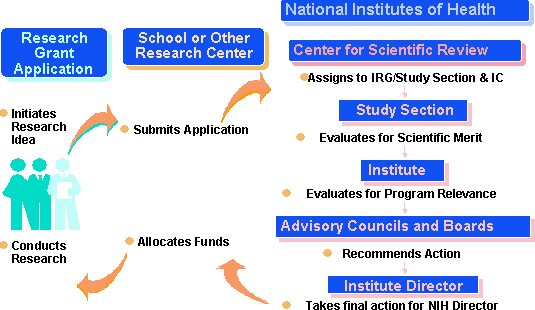
| 1年間に重複して3サイクル: 各サイクルで17,000〜18,000件の申請書(年間約54,000件) |
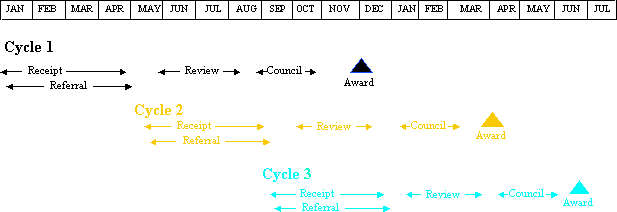
| ● | グラント申請書の受付 |
| ● | 申請書をCSRの審査委員会(Review Group)あるいは各Instituteの審査委員会に振り分ける。 |
| ● | 各申請書について助成Instituteを決める。 |
| ● | CSR内の100以上の審査委員会で大半のグラント申請書の一次審査(科学的メリット)を行う。 |
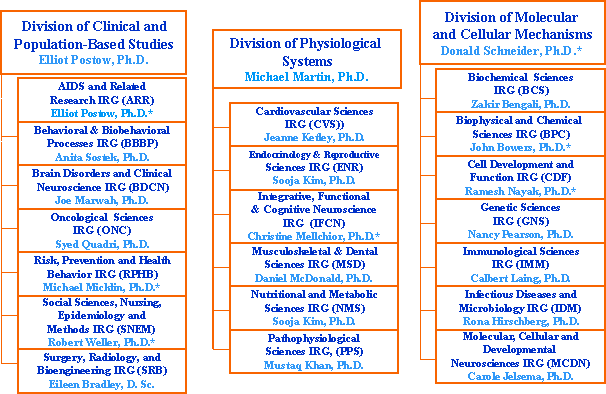
*Acting |
| ● | Scientific review groups:
| ||||||
| ● | Institutes:
|
NIH eRA Objective(電子申請処理システム): |
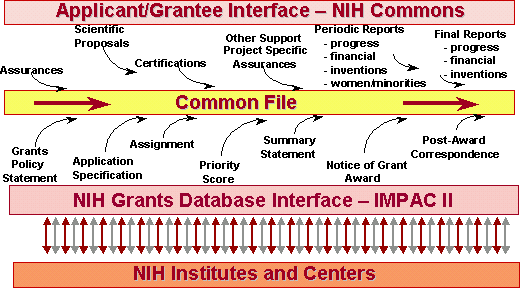
| ● | CSR の審査委員会は、Scientific Review Administrator(SRA)が運営している。SRAはPh.D.レベルの専門家で、当該審査委員会で扱う分野に関する深い専門知識を有している。 |
| ● | CSRの常設審査委員会は15-25人の外部研究者からなる。(任期4年、25%を毎年入れ替え、少なくとも25%は女性またはminorityから) |
| ● | 1回の審査委員会で60-100の申請書を審査する。 |
| ● | Demonstrated Scientific Expertise(専門性) |
| ● | Doctoral Degree or Equivalent(博士号相当) |
| ● | Mature Judgment (判断力) |
| ● | Work Effectively in a Group Context(協調性) |
| ● | Breadth of Perspective(見識) |
| ● | Impartiality(公平性) |
| ● | Interest in Serving(奉仕の精神) |
| ● | Adequate Representation of Women and Minority Scientists(女性・マイノリティの参加) |
負担
|
| 1. | 特別な養成研修は行っていない。 →既にグラント獲得経験のある優れた研究者 |
| 2. | peer reviewに関するオリエンテーション用文書を渡す。個別に説明をする。 |
| 3. | 最初は単発で依頼 →能力・適性をみながら正式メンバーにする。 |
| 4. | 年上のreviewerとペアにすることもある。 |
| 5. | review process自体が、reviewerにとっても重要な教育機会である。 |
This will certify that in the review of applications and proposals by (study section) on (date), I did not participate in the evaluation of any grant or fellowship applications from (1) any organization, institution or university system in which a financial interest exists to myself, spouse, parent,child, or collaborating investigators; (2) any organization in which I serve as officer, director, trustee, employee or collaborating investigator; or (3) any organization which I am negotiating or have any arrangements concerning prospective employment or other such associations. |
| ● | 誰がどの申請書を審査したのか、外部者、申請者にはわからない。ただし、審査委員会全体の名簿は公表。 |
| ● | reviewer自身も当該申請書の他のreviewerが誰なのか当日までわからない。 |
| ● | 審査会合以外では申請書についての会話厳禁。配布文書は全て回収または破棄 |
| ● | 申請書に関する質問、意見は全てSRAのみに伝える。 |
SRAが、1申請書につき3人の事前審査者を割り当てる
|
| ● | Significance | (重要性) |
| ● | Approach | (方法) |
| ● | Innovation | (革新性) |
| ● | Investigators | (研究者) |
| ● | Environment | (研究環境) |
Overall Evaluation & Score Reflects Impact on Field
| ● | Significance: Does this study address an important problem? If the aims of the application are achieved, how will scientific knowledge or clinical practice be advanced? What will be the effect of these studies on the concepts, methods, technologies, treatments, services, or preventative interventions that drive this field? |
| ● | Approach: Are the conceptual or clinical framework, design, methods, and analyses adequately developed, well integrated, well reasoned, and appropriate to the aims of the project? Does the applicant acknowledge potential problem areas and consider alternative tactics? |
| ● | Innovation: Is the project original and innovative? For example: Does the project challenge existing paradigms or clinical practice; address an innovative hypothesis or critical barrier to progress in the field? Does the project develop or employ novel concepts, approaches, methodologies, tools, or technologies for this area? |
| ● | Investigators: Are the investigators appropriately trained and well suited to carry out this work? Is the work proposed appropriate to the experience level of the principal investigator and other researchers? Does the investigative team bring complementary and integrated expertise to the project (if applicable)? |
| ● | Environment: Does the scientific environment in which the work will be done contribute to the probability of success? Do the proposed studies benefit from unique features of the scientific environment, or subject populations, or employ useful collaborative arrangements? Is there evidence of institutional support? |
| 1. | 各項目について、1(best)→5(worst)の5段階で採点。(×100として表示) |
| 2. | 最初に3人の事前審査者(primary reviewer)が採点を発表する。 |
| 3. | 異議のない限り、悪い点数(2.5または3以上)の時は、それ以上審査しない。→Unscored |
| 4. | 良いものについて、1申請書あたり20〜25分間討議。 |
| 5. | 全員で採点し、平均点がその申請書の得点(priority score)になる。→Scored |
| 6. | また、上から何%目になるか(パーセンタイル値)も算出する。 |
| 7. | 情報が足りない等の理由で差し戻しとなることもある。→Deferral |
| ● | priority scores と percentile rankingsの算出 |
| ● | summary statements(審査結果報告書)の取りまとめ、送付 |
| Once applications are reviewed, the results are documented by the SRA in a summary statement and forwarded to the Institute (and the PI) where a funding decision is made: summary statement の内容:
|
|
|
|
| ● | Effective for all new applications received after October 1, 1998 | ||||||||
| ● | Child is defined as an individual under age 21 | ||||||||
| ● | If children are included, Investigator must address
|
| ● | 一次審査への同意 |
| ● | 一次審査の修正 |
| ● | 再審査の決定 |
| 1. | 各Institute/CenterのCouncilでの審査を経て、Institute Directorに上げられる。(Institute Directorが最終決定者。) |
| 2. | 予算枠の85%までは、パーセンタイル順で決定。 |
| 3. | 残りの15%はprogram directorらの意見を参考に決定。 |
| 4. | Pay lineは上位25%程度。 |
| 1. | Review Process (審査プロセス) Decision Making (意思決定) Program Support (研究支援)の分離。 |
| 2. | 公平性,透明性を担保するシステムを構築。 特に、利害関係の排除、守秘の厳守には細心の注意 → 国民や議会に対する説明責任 |
| 3. | Administration(管理部門)に各分野の(研究経験のある)専門家を充てている。 |
| ● | Acquisition - contracts(契約型) | ||||
| ● | Assistance - grants(グラント型) | ||||
| ● | Objective review(主として契約型に対して)
| ||||
| ● | Peer review(主としてグラント型に対して)
|
| ● | PGO( Procurement and Grants Office )の構成:11の Branch/Team |
| ● | 各ブランチ/チームは、それぞれ数名から数十名のスタッフからなり、全体としてCDC内の各CIOと密接に連携を保ち、研究費が適切に管理されるように様々な業務を行っている。 |
| ● | 研究費公募のための広報、申請の受付、評価委員の選択、評価会議の開催、採択結果の公表、研究費の配分などである。 |
| ● | 各業務にそれぞれ専門のスタッフが関わっている。 |
| ● | Information Resources Management Office | ||||||||||||||||||||||
| ● | Management Analysis and Service Office | ||||||||||||||||||||||
| ● | Procurement and Grants Office(PGO)
|
| ● | 守秘義務(Confidentiality) | ||||
| ● | 利害関係(Conflict of Interest) | ||||
| ● | 評価者の出席(Attendance) | ||||
| ● | 評価
| ||||
| ● | 結果報告書(Summary Statements) |
| ● | 守秘義務( Confidentiality )
| ||||||||
| ● | 利害関係( Conflict of Interest )
|
| ● | プレ・ミーティング(Pre-meeting) | ||||
| ● | 全体会議(Plenary session)
| ||||
| ● | 各委員会(Panel session)
|
| ● | 研究のニーズ | 0〜10 |
| ● | データ入手の可能性 | 0〜20 |
| ● | 研究目的 | 0〜15 |
| ● | 研究方法 | 0〜30 |
| ● | 計画の管理とスタッフ | 0〜15 |
| ● | 自己評価に関する計画性 | 0〜10 |
| ● | CDCが配分している研究費は主に契約型とグラント型の2種類に分けられ、金額及び件数の両面で前者が多くの割合を占めている。 |
| ● | 評価基準については、契約型とグラント型とでは重点の置き方が大きく異なる。 |
| ● | 研究費交付可否を決定する際、申請された研究テーマのニーズ、研究計画の妥当性など、複数の観点から厳密な評価が行われている。CDCでは評価者の人選にあたって5000人以上の評価委員候補者のデータベースを効率的に利用している。 |
| ● | 助成の意思決定プロセスの透明性の向上 |
| ● | ピアレビューの公平性の確保(特に利害関係の排除と審査員の多様性) |
| ● | グラント型助成(探索的研究)と契約型助成(行政支援的研究)の区別の明確化 |
| ● | 研究者の育成を促すシステムの拡充(審査結果報告書、研究のわかるアドミニストレーター) |
| ・ | 米国イリノイ大学シカゴ校公衆衛生大学院及びシカゴ大学医学部の医学・公衆衛生学研究者を対象に、意見を聴取した。調査対象者は、研究協力者の協力を得て、両機関から選択した。 |
| ・ | 合計11名に面接した。全員がNIHグラントの経験者で、ほぼ全員が審査員(Reviewer)の経験があった。 |
| (1) | 米国NIHのグラント審査システムの長所と短所は何か。 |
| (2) | 短所がある場合、どのような改善が必要か。 |
| (3) | 研究の事後評価の指標として、発表論文数の他に何が考えられるか。特に研究が社会に与えるインパクトをどのように評価するか。 |
| (1) | 米国NIHのグラント審査システムの長所と短所は何か。 |
| ・ | 審査委員会は20〜30名からなり、様々な研究グループの人間から成り立っている。しかも、申請者と利害関係にある審査員は審査から外れなければならない。 |
| ・ | 年配の研究者だけではなく、しがらみの少ない若い研究者も入るので、有名大学によるグラントの独占やボス支配は起こりにくい。 |
| ・ | 民間の施設に勤める実務者が入ることもあり、学術的な価値よりも社会的な価値から意見を言うので、これまで光が当たらなかった分野でグラントが認められることがある。 |
| ・ | 適切な審査員が見つからないという問題点がある。ある分野に最も精通している研究者は、しばしば審査員になりたがらない。その結果、審査委員会のメンバーの質にばらつきが出る。 |
| ・ | 声の大きい2,3人の審査員に全体の意見が引きずられてしまうことがある。 |
| ・ | 審査委員会ごとに明確な審査基準がないために、審査員によって採点にばらつきがでてしまうこともある。RFA(特定の課題に対する募集)の場合は、どのような審査基準かが明記してある。ただ、全体からするとRFAの割合は小さい。 |
| ・ | 審査がたいへん保守的で、革新的だがリスクの高い研究申請に高い点数が付かないことがある。新しいアイディアの研究ほど前例となる研究やデータがないものである。 |
| ・ | 大きなグラント審査の場合、審査委員会によってはSite Visit(実地検分)を行う。これに費やす労力は審査員、申請者双方にとって膨大なものである。この準備にかける労力だけで実際の研究が一つできてしまう。 |
| ・ | 社会科学に対しては、審査委員会に理解のある人が少なく、研究計画に様々な注文をつけてくることが多い。そのため、修正して再申請を繰り返していると、承認まで無意味に時間がかかってしまう。 |
| ・ | 全ての申請書が、等しく同じ関心を持って審査されていない場合がある。これは、審査員の労働負荷が大きいことによる。1年に3回ワシントンに行くが、事前に担当する10申請書を読み、コメントを書くのに2週間かかる。これは、大学の仕事外の負担となる。 |
| ・ | 大学は職員に対して、より多くのグラントをとるようにプレッシャーをかけるので、申請数は毎年増加している。これは、申請者、審査者双方にとって、ストレスを増大させる事態を招いている。他の国では、もっとうまくやっているのではないかという気もする。 |
| ・ | ある分野に研究資金が集中することがある。今は、Bio-terrorismでしばらく前はHIV/AIDSだった。人々は、その嵐が過ぎ去ると、なぜこの分野にこんなにお金を使うのかと言うものだ。 |
| ・ | 今後この方向の研究を進めていったらいいという決定には、科学者の適切な意見が反映されるようになっている。ただ。そのように決定された優先順位が、必ずしも科学者全体の見方を反映していないことがある。 |
| 1. | 高水準の公正さ(Fairness)が担保されているとの認識は共有されている。 |
| 2. | その上で、審査員の質のばらつき、審査プロセスの煩雑さ、審査員の高負担が指摘されている。 |
| 3. | 助成方針について、科学者の意見と政治的意図・世論との葛藤が存在する。 |